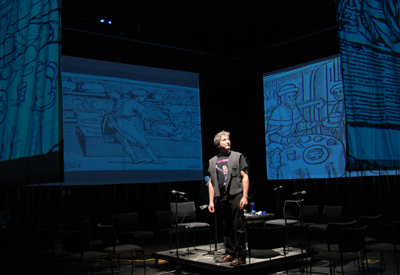An 'Opera of Meaning' Integrates Live Performance, Internet, Multimedia and Audience Participation at UC San Diego
San Diego, CA, March 1, 2008 -- Kamza and Bar Kamza is an innovative, interactive theatrical piece that is hard to categorize. Told in four acts broken into 16 short scenes, it is set to sound, visuals and semantic web technology. There are two performers per se but the audience is encouraged to chime in. It is a live event but integrates pre-taped video clips. The principal creator is a professor of music at UC San Diego but the project is deeply interdisciplinary -- integrating expertise in economic theory, digital media, history, Judaic studies, Web 2.0 software tools, conflict resolution and more.
|
The interdisciplinary performance will be on display for the first time when professor Shlomo Dubnov's work-in-progress is staged on March 5 at 7 p.m on the UCSD campus. The Calit2 Theater venue in Atkinson Hall is a reconfigurable space created by the California Institute for Telecommunications and Information Technology (Calit2) precisely to encourage new forms of live performance and new media.
[Seating is limited, but the public is invited to register for available seats. RSVP to Lynda Tran at lynda@ucsd.edu .]
The Kamza and Bar Kamza narrative traces its roots to the Talmud, and a parable about the destruction of Jerusalem. But Dubnov is quick to point out that it is not about religion, nor really about the story itself. The scenes in Act I for instance include "On the nature of scrupulousness" and "Culture of sacrifice." "The story is about the questions the parable raises and not so much about the actual narrative," said Dubnov. "It's a story to debate, and this is the whole Talmudic issue: you want to debate, not present one view." Commentary transitions between scenes, and debates occur between acts.
|
According to Dubnov, the interactive piece is a "parallel artistic thought" to the rise of communications technology as a dominant factor in modern culture. He calls Kamza and Bar Kamza an "opera of meaning." "In our contemporary experience, art, music and media cannot be separated from the flow of information," said Dubnov. "So the whole production is based on materials retrieved from the Internet and through interaction among the audience and performers in a manner that is suggestive of today's social software networks and online communities."
"Some of the inspiration for exploring this new form of presentation comes from methods of debate and commentary that are common in traditional religious academic situations," added Dubnov, pointing to examples such as "Mishna studies in the Jewish tradition, and debates and commentary in Tibetan Buddhism and Buddhist philosophy."
"I am especially proud of our graduate student team, whose combined skills allowed the making of the show to be a true collaborative experience," said Dubnov. "Ignacio Lopez brings a uniquely diverse background in religious studies, visual and sonic art, and incredible abilities in production management. Toby Algya's expertise is in programming and various aspects of theatrical design, while Benjamin Kay brought his academic methodology in research and supervised the undergraduates who participate in the show."
The two principal performers will be located literally at the center of this theater-in-the-round performance. World-renowned percussionist Steven Schick and vocalist Philip Larson are members of the Department of Music faculty. Shaped as a structured improvisation, the music emerged as a collaborative research with Schick and Larson. "We wanted to look into aspects of gesture and rhetoric as mediators of meaning," explained Dubnov. "Some of the sound is captured and augmented by sensors that were designed and developed by members of the team."
Other project collaborators include Joel Sobel and Eli Berman, members of UCSD's economics faculty; history professor David Goodblatt; and Morana Alač, a professor of communication and science studies, who integrated Kamza and Bar Kamza into an undergraduate course. The students developed their own stories and ideas around the parable, and will participate in the dialogue - with interjections aimed at eliciting spontaneous responses from other audience members.
"I think that the central theme is about a sense of belonging-to a social group, to the country, to the world," said Dubnov. "What we want to do is raise awareness of the dilemmas that everyone faces, where they make decisions between their own self interest and society's best interests that may determine whether the society will collapse."
In the months following the March 5 event, Dubnov will compile materials from the event and arrange them in a database. These elements will be archived online, allowing retrieval and re-use according to different topics which occur in the process of personal viewing or additional public performances. The performance is also being captured in high-definition video by Calit2, for a planned documentary on the project.
Dubnov plans to present the next interactive Kamza and Bar Kamza play in 2009, in San Diego and Paris, in conjunction with Centre Pompidou's Institute for Research and Innovation (IRI), where the goal of collaboration is to focus on the study and development of cultural and learning technologies that can benefit society.
The project's final phase will summarize the results and develop a methodology for using the debate and commentary play in additional contexts, with the emphasis on educational usage and broad delivery in compelling digital formats that could include DVDs, podcasts, collaborative web platforms, annotation tools, mobile technologies, multimodal interfaces, and digital design.
Related Links
Media Contacts
Media Contacts: Doug Ramsey, 858-822-5825, dramsey@ucsd.edu and Dirk Sutro, Music, dsutro@ucsd.edu


